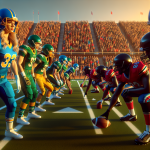As the NFL’s regular season approaches the halfway mark, there’s no shortage of business and off-field issues percolating around the league. And as the World Series takes center stage in the sports ecosystem, I’ll compare the NFL’s salary cap system to Major League Baseball operating without a cap. After that, I’ll analyze the curious Haason Reddick holdout, the “same but different” trade compensation for Davante Adams and Amari Cooper, and the NFL’s deference to Tom Brady the owner-as-broadcaster.
As I talk about and teach to my students, a salary cap is a collectively bargained mechanism to promote competitive balance between teams in leveling the financial playing field and protect owners from themselves. While the NFL has had a salary cap since the inception of free agency in 1993, Major League Baseball has never had one and, at least this year, the results in that league reflect what is not always true in sports, which is: more spending = more winning.
This year’s two World Series teams hail from the two largest markets in the country with two of the three highest payrolls in baseball. The New York Yankees ($311 million) and Los Angeles Dodgers ($266 million) are second and third in player spending, with the top team (the New York Mets at $332 million) just eliminated in the NLCS by the Dodgers. Baseball does have another method to ostensibly promote parity, as the competitive balance tax (CBT) levies penalties to deter high-spending teams, but there are no stop signs or penalties—other than contributing to a fund for lower-revenue teams—for zooming past the CBT.
In sharp contrast, the NFL not only has a cap, but a team can never be “over the cap.” Were a team to submit a contract that would take it beyond the cap, the NFL would reject the deal until the team made a corresponding move—a release or restructure—to create the needed cap space.
An informative way to illustrate the differences between an MLB system and the NFL system is to look at the disparity in player payroll from the highest spending team to the lowest spending team. Over the past five years in Major League Baseball, the average payroll disparity between the highest- and lowest-spending teams is over $200 million. Over the past five years in the NFL, the average payroll disparity between highest- and lowest-spending teams is under $100 million.
This past MLB season saw the Mets and Yankees with payrolls over $300 million and six teams with payrolls under $100 million. Yes, teams on the lower end of that scale (such as the Detroit Tigers) do rise up and contend, but without a salary cap: The odds are stacked against that, there is no margin for error with lower payrolls and success is not sustainable without spending.






